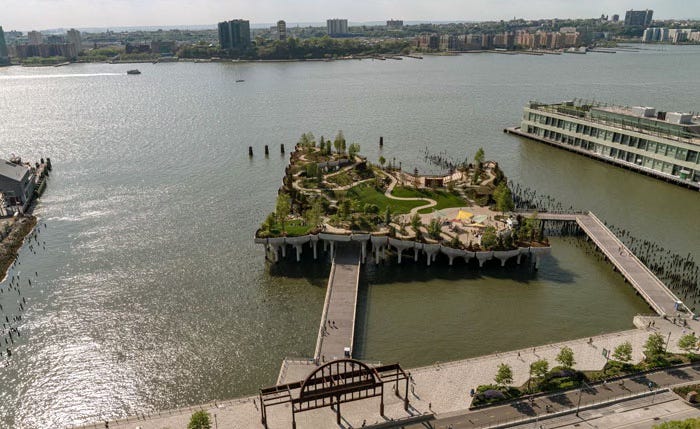Behold, the “Little Island” mini-park in the Hudson River, occupying the former site of Pier 54, now demolished, where survivors of the Titanic landed in 1912. This is the second big public art statement installed around the lower Manhattan Meatpacking District — the first was the High Line, a linear above street-grade trail wending between blocks on the foundation of an old elevated railroad trestle that used to service the industries that no longer exist there. The High Line was built before Covid-19 destroyed New York City’s latest business model (as the counting-house for the asset-stripping of Flyover America). Both works are interesting civic decor stunts that actually tell interesting stories far different than what you see superficially.
The main message of both is that the city streets themselves are beyond hopeless as far as creating rewarding urban space for humans. Just fuggeddabowt it. This is, or course, a complete refutation of urban design per se. Rather, in these constructions “nature” is fetishized as something apart from the fabric of the city, something only experienced via formal programming. Here’s that nature you ordered. Now form a line…!
Another message is that the USA’s foremost harbor is not expected to function as a seaport anymore, ever. Instead, it will be the site of heroic conceptual artworks aggrandizing the arty classes of society. Note to readers: the time will come — and probably not that far into the future — when the region will need a working waterfront along the Hudson River. I know that’s hard to believe but that’s where reality is taking us. Another note to readers: the arty classes of today will go extinct in the resource-and-capital scarcity-constrained decades ahead. All the financial infrastructure that currently supports this class of pretentious idlers — the foundations, the government hand-outs, the grad schools, the endlessly-replicating museums — will be history and only those people skilled in the practical arts will earn a livelihood. You get a sense of the current reigning twee sensibility in this excerpt from Michael Kimmelman’s review of Little Island in The New York Times:
Rising from the Hudson River, Little Island preens atop a bouquet of tulip-shaped columns, begging to be posted on Instagram. Outside, it’s eye candy. Inside, a charmer, with killer views.
Mega-mogul Barry Diller’s $260 million, 2.4-acre pet project and civic mitzvah, near 13th Street in Hudson River Park, is the architectural equivalent of a kitchen sink sundae, with a little bit of everything. Who knows what it will feel like when crowds arrive this weekend. I suspect they will be enormous.”
We’re informed further down that Little Island has a whole staff of arts programmers for the two performance spaces on it: a 687-seat amphitheater and a little stage in a glade of trees. I hope Barry Diller set up a trust to keep paying for all that because New York City is on its way to going stone broke, with office towers running at 20 percent occupancy and gainfully employed taxpayers fleeing to the work-from-home burbs (another tragic development, by the way). New York could barely maintain its subway system pre-Covid, when financialization was funneling all those stripped assets to Wall Street. Prediction: within two years Little Island will be an especially choice encampment site for the homeless to pitch their tents. Wait for it….
Little Island was designed by Thomas Heatherwick, same guy who designed The Vessel, featured as the October 2016 Eyesore of the Month
Thanks to Franklin Vaugn for this month’s nomination.





